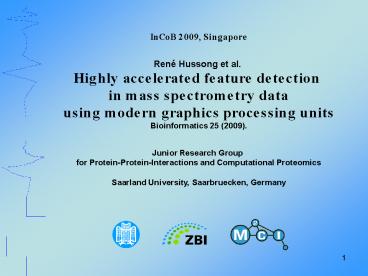Folie 1 - PowerPoint PPT Presentation
Title:
Folie 1
Description:
for Protein-Protein-Interactions and Computational Proteomics ... Mass Spectrometer. List of differentially. expressed proteins ... – PowerPoint PPT presentation
Number of Views:26
Avg rating:3.0/5.0
Title: Folie 1
1
InCoB 2009, Singapore René Hussong et al.
Highly accelerated feature detection in mass
spectrometry data using modern graphics
processing units Bioinformatics 25
(2009). Junior Research Group for
Protein-Protein-Interactions and Computational
Proteomics Saarland University, Saarbruecken,
Germany
2
Outline
Introduction Motivation - The Differential
Proteomics Pipeline
Computational Proteomics - Signal Processing
and Feature Detection - The Isotope Wavelet
Transform
Parallelization via GPUs
Results Discussion
3
The Differential Proteomics Pipeline
Two probes e.g. sick vs. healthy
List of differentially expressed proteins
Mass Spectrometer
Applications range from basic pharmaceutical
research over medical diagnostics and therapy to
biotechnology and engineering.
4
Principle of Biological Mass Spectrometry
Peptides are ionized and accelerated
Proteins
Peptides
intensity
Fingerprint
mass
5
Principle of Biological Mass Spectrometry
mass of a single neutron
intensity
Fingerprint
mass
6
Principle of Biological Mass Spectrometry
mass of a single neutron
intensity
Fingerprint
mass
7
(Simple) Feature Finding
Typically done by simple thresholding
- Needs additional preprocessing steps, like e.g.
- - Baseline elimination (e.g. by morphological
filters) - - Noise reduction and/or smoothing
- ? (Mostly) needs resampling
Needs additional postprocessing steps, like
e.g. - Peak clustering (so-called
deconvolution) - Model fitting, charge
prediction
8
The Isotope Wavelet Transform
Convolution with a kernel function
- - by construction robust against noise and
baseline artifacts - also acts as a filter for chemical noise
- predicts simultaneously the charge state
- needs no explicit resampling
- only a single parameter (threshold)
9
Results Myoglobin PMF
10
Parallelization via CUDA
11
Parallelization via CUDA
12
Parallelization via CUDA
b-th data point
13
Parallelization via CUDA
b-th data point
14
Parallelization via CUDA
b-th data point
15
Parallelization via CUDA
b-th data point
16
Parallelization via CUDA
b-th data point
T0
Tn
17
Parallelization via CUDA and TBB
1x CPU 2.3 GHz
1x NVIDIA Tesla C870
2x NVIDIA Tesla C870 via Intel Threading Building
Blocks
gt200x speedup
18
Open Issues Future Work
Solutions for machine-specific artifacts,
e.g. - Tailing effects in TOF-Analyzers -
Severe mass discretization in high resolution
data
Tests for MSn spectra - Refined averagine
model
Separating overlapping patterns
GPU solutions
19
Availability OpenMS
An open source C library for mass
spectrometry
Designed for users as well as for
developers
TOPP - The OpenMS proteomics pipeline -
suite of independent software tools - include
file handling / conversion - peak picking and
feature detection - includes visualizer
TOPPView
http//www.openms.de
20
References
Hussong, R, Gregorius, B, Tholey, A, and
Hildebrandt, A (2009). Highly accelerated
feature detection in proteomics data sets using
modern graphics processing units. Bioinformatics
25. Schulz-Trieglaff, O, Hussong, R, Gröpl, C,
Leinenbach, A, Hildebrandt, A, Huber, C, and
Reinert, K (2008). Computational Quantification
of Peptides from LC-MS Data. Journal of
Computational Biology 15(7). Sturm, M, Bertsch,
A, Gröpl, C, Hildebrandt, A, Hussong, R, Lange,
E, Pfeifer, N, Schulz-Trieglaff, O, Zerck, A,
Reinert, K, and Kohlbacher, O (2008). OpenMS - An
open-source software framework for mass
spectrometry, BMC Bioinformatics
9(163). Hussong, R, Tholey, A, and Hildebrandt,
A (2007). Efficient Analysis of Mass Spectrometry
Data Using the Isotope Wavelet In COMPLIFE 2007
The Third International Symposium on
Computational Life Science. American Institute of
Physics (AIP) 940. Schulz-Trieglaff, O, Hussong,
R, Gröpl, C, Hildebrandt, A, and Reinert, K
(2007). A Fast and Accurate Algorithm for the
Quantification of Peptides from Mass Spectrometry
Data, In Proceedings of the Eleventh Annual
International Conference on Research in
Computational Molecular Biology (RECOMB). Lecture
Notes in Bioinformatics (LNBI) 4453.
21
The Isotope Wavelet Transform
Convolution with a kernel function
- - by construction robust against noise and
baseline artifacts - also acts as a filter for chemical noise
- predicts simultaneously the charge state
- needs no explicit resampling
- only a single parameter (threshold)
Kernel function charge state 1, mass 1000D
Kernel function charge state 1, mass 2000D
22
The Isotope Wavelet Transform
MS spectrum (charge state 3)
charge-1-transform
charge-2-transform
charge-3-transform
23
The Sweep Line Idea
2 additional parameters RT_cutoff RT_interleave
RT s
m/z Th
24
Open Issues Future Work
Fragment Fingerprint
intensity
charge state 1
Fingerprint
mass/charge
25
Open Issues Future Work
Separating overlapping patterns
26
The Retention Time
27
Results 2D noisy data
28
The Adaptive Isotope Wavelet Kernel
- q denotes the Heaviside step function - ?(m) is
a linear function fit to the averagine model































